Peptic ulcers are common gastrointestinal disorders affecting millions worldwide. They involve open sores in the stomach or duodenum, causing pain and discomfort. Diet plays a crucial role in managing symptoms and promoting healing, with a focus on avoiding irritants and adopting a balanced, bland diet.
1.1 Definition and Prevalence
Peptic ulcers are open sores in the stomach lining or duodenum, causing pain and discomfort. They affect millions globally, impacting people of all ages, genders, and races. While prevalent in those over 60, they can occur at any age. Gastric and duodenal ulcers are the most common types, with Helicobacter pylori infection and NSAID use being key contributors to their development.
1.2 Types of Peptic Ulcers (Gastric and Duodenal)
Peptic ulcers are primarily categorized into gastric and duodenal types. Gastric ulcers occur in the stomach lining, while duodenal ulcers develop in the upper part of the small intestine. Both types involve mucosal erosion, often due to Helicobacter pylori infection or NSAID use. Symptoms include upper abdominal pain, bloating, and heartburn, with dietary adjustments playing a key role in managing both forms effectively.
The Role of Diet in Managing Peptic Ulcers
Dietary modifications are essential in managing peptic ulcers, helping reduce symptoms and promote healing by avoiding irritants and incorporating foods that support mucosal repair and digestion.
2.1 Importance of Dietary Modifications
Dietary modifications are crucial for managing peptic ulcers as they help reduce stomach acid production and minimize irritation. By avoiding trigger foods like spicy, acidic, and high-fat options, individuals can alleviate symptoms and promote healing. A tailored diet not only eases discomfort but also supports the body’s natural repair processes, preventing complications and enhancing overall recovery.
2.2 Overview of the Peptic Ulcer Diet
The peptic ulcer diet focuses on balanced nutrition to reduce symptoms and promote healing. It emphasizes small, frequent meals, avoiding irritants like spicy or acidic foods, and incorporating lean proteins, whole grains, fruits, and vegetables. The diet also highlights the importance of probiotics and low-fat dairy to support gut health, while advising against caffeine, alcohol, and high-fat foods that can trigger discomfort.
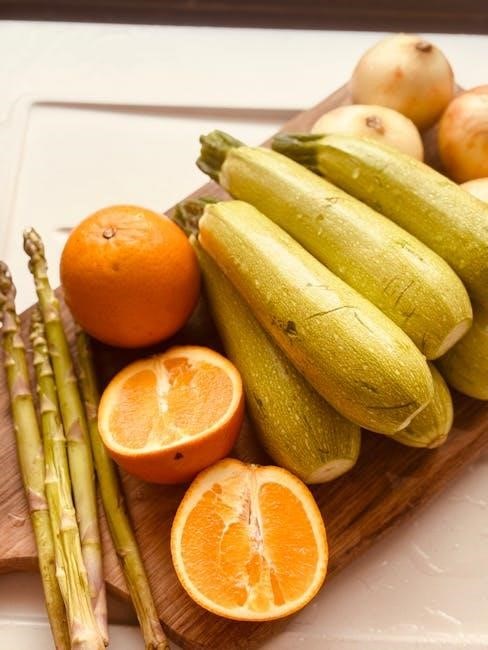
Foods to Avoid
Patients with peptic ulcers should avoid acidic, spicy, and high-fat foods, as well as caffeine, alcohol, and smoking, which can worsen symptoms and delay healing.
3.1 Acidic and Spicy Foods
Acidic foods like citrus fruits and tomatoes, as well as spicy foods such as chili peppers, can irritate the stomach lining, worsening peptic ulcer symptoms. These foods increase stomach acid production, delaying healing and causing discomfort. It’s best to avoid or limit their consumption to prevent aggravating the condition and promote a smoother recovery process for individuals with peptic ulcers.
3.2 High-Fat and Fried Foods
High-fat and fried foods slow digestion, increasing pressure on the stomach and triggering acid production. These foods can worsen peptic ulcer symptoms like pain and discomfort. Avoiding them helps reduce irritation and supports the healing process, making it easier to manage the condition effectively.
3.3 Caffeine, Alcohol, and Smoking
Caffeine, alcohol, and smoking significantly worsen peptic ulcer symptoms by increasing stomach acid production and irritating the stomach lining. Caffeine stimulates acid secretion, while alcohol directly damages the mucosa. Smoking impairs healing, reduces protective mucus, and increases acid production. Avoiding these substances is crucial for managing symptoms and promoting recovery.
Recommended Foods
Recommended foods for managing peptic ulcers include lean proteins, low-fat dairy, whole grains, fruits, vegetables, and probiotic-rich foods. These options help reduce inflammation and promote healing.
4.1Lean Proteins and Low-Fat Dairy
4.1 Lean Proteins and Low-Fat Dairy
Lean proteins like chicken, turkey, and fish are essential as they are easy to digest and support healing without irritating the stomach lining. Low-fat dairy products, such as yogurt and milk, provide calcium and probiotics, which can aid in soothing and protecting the stomach. These foods help maintain a balanced diet while minimizing acid production.
4.2Whole Grains, Fruits, and Vegetables
4.2 Whole Grains, Fruits, and Vegetables
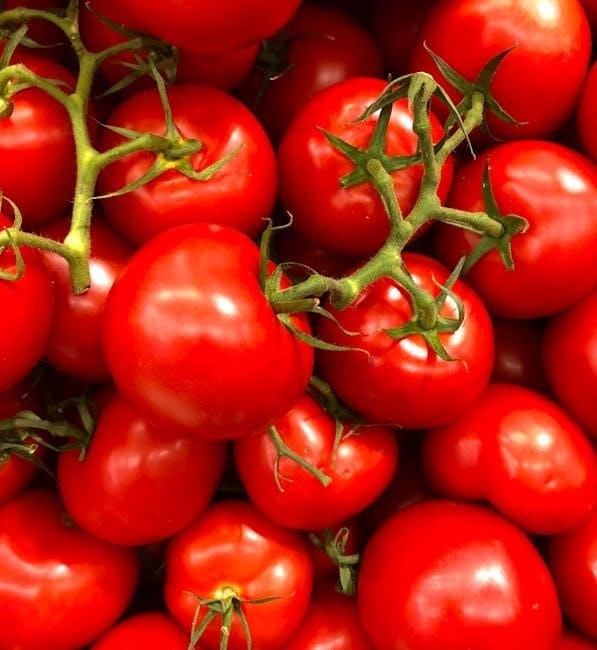
Whole grains, fruits, and vegetables are rich in fiber and antioxidants, which aid digestion and reduce inflammation. They help heal the stomach lining and prevent ulcers. Choose non-acidic fruits like bananas and melons, and steamed or cooked vegetables to minimize irritation. These foods promote a balanced diet and support overall gastrointestinal health, making them essential for managing peptic ulcers effectively.
4.3Probiotic-Rich Foods
4.3 Probiotic-Rich Foods
Probiotic-rich foods, such as yogurt, kefir, sauerkraut, and kimchi, support gut health by balancing beneficial bacteria. These foods reduce inflammation, enhance digestion, and may alleviate ulcer symptoms. Probiotics also help mitigate side effects of antibiotics used to treat H. pylori, making them a valuable addition to a peptic ulcer diet. Incorporating these foods promotes healing and supports a healthy stomach lining.
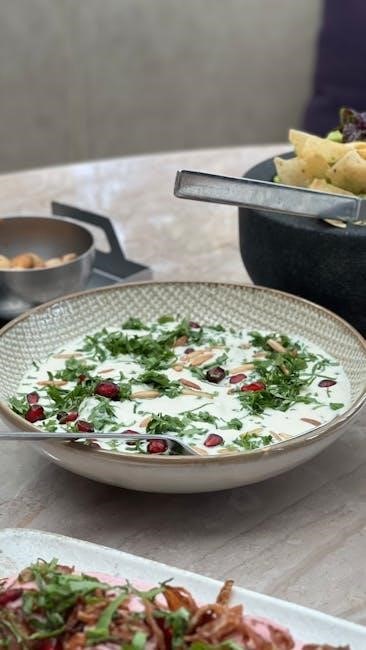
Lifestyle Modifications
Lifestyle changes are crucial for managing peptic ulcers. Eating smaller, frequent meals, avoiding late-night eating, and practicing stress reduction techniques can help alleviate symptoms and promote healing.
5.1Eating Patterns (Small, Frequent Meals)
Eating smaller, more frequent meals helps manage peptic ulcers by reducing stomach acid production and pressure. Aim for 3 main meals and 3 snacks spaced evenly throughout the day. Avoid overeating, as it can exacerbate symptoms. Opt for lean proteins, whole grains, and low-fat foods, and avoid foods that cause discomfort. Eating slowly and chewing thoroughly aids digestion and reduces irritation.
5.2Avoiding Late-Night Eating
Avoiding late-night eating is crucial for managing peptic ulcers, as lying down after meals can worsen symptoms. Stop eating at least 2-3 hours before bedtime to reduce stomach acid production. This helps prevent acid reflux and irritation during sleep, promoting healing and minimizing discomfort. Eating in a calm, relaxed atmosphere also supports digestion and reduces gastric stress.
5.3Stress Reduction Techniques
Stress can exacerbate peptic ulcer symptoms by increasing stomach acid production. Engaging in stress reduction techniques like deep breathing exercises, yoga, or meditation can help alleviate discomfort. Eating in a calm, relaxed atmosphere also supports digestion. These practices promote healing and reduce the overall burden on the gastrointestinal system, making them essential for managing peptic ulcers effectively.

Bland Diet for Peptic Ulcers
A bland diet focuses on low-acid, easily digestible foods to reduce stomach irritation and promote healing. It avoids spicy, fatty, and acidic foods, recommending small, balanced meals to manage symptoms effectively.
6.1Foods Allowed in a Bland Diet
6.1 Foods Allowed in a Bland Diet
A bland diet for peptic ulcers includes low-acid, non-irritating foods like whole grains, lean proteins, low-fat dairy, and steamed vegetables. Non-acidic fruits such as bananas and apples are permitted, along with low-fat soups and herbal teas. These foods are chosen to minimize stomach irritation and promote healing while providing essential nutrients for overall health and recovery.
6.2Foods to Exclude
6.2 Foods to Exclude
Foods to exclude in a bland diet for peptic ulcers include spicy, acidic, and high-fat items. Avoid citrus fruits, tomatoes, chocolate, caffeine, alcohol, and carbonated drinks. Fried foods, processed meats, and heavy sauces should also be avoided. Smoking and excessive salt intake can worsen symptoms. These foods and habits can irritate the stomach lining, delaying healing and exacerbating discomfort.
Monitoring Progress and Adjustments
Regularly track symptoms like pain and discomfort, and schedule follow-ups with your healthcare provider to assess healing and adjust your diet plan as needed.
7.1Tracking Symptoms
7.1 Tracking Symptoms
Monitoring symptoms like stomach pain, bloating, and heartburn is essential. Keep a journal to record when symptoms occur, their severity, and any food triggers. This helps identify patterns and assess how dietary changes impact healing. Regularly reviewing symptom logs with your healthcare provider ensures personalized adjustments to your treatment plan, promoting better management of peptic ulcer symptoms and overall recovery.
7.2Consulting a Healthcare Provider
7.2 Consulting a Healthcare Provider
Regular consultations with a healthcare provider are crucial for managing peptic ulcers. They can offer personalized dietary advice, monitor healing progress, and adjust treatment plans. Discussing symptom improvements or challenges ensures tailored recommendations. Providers may also recommend tests or medications to support recovery, emphasizing the importance of a collaborative approach to effectively manage the condition and prevent recurrence.
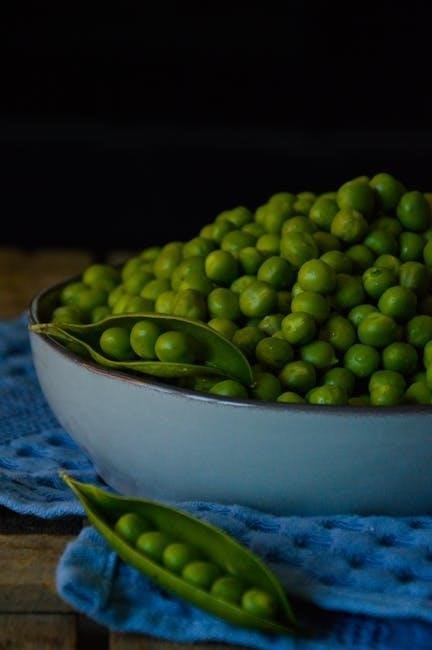
High-Fiber and Probiotic-Rich Diets
High-fiber and probiotic-rich diets aid in healing peptic ulcers by reducing inflammation and supporting gut health, which can alleviate symptoms and promote recovery effectively.
8.1 Benefits of High Fiber
A high-fiber diet aids in managing peptic ulcers by soothing the digestive tract and reducing inflammation. Fiber-rich foods like whole grains, fruits, and vegetables help regulate stomach acid, prevent irritation, and promote healing. Additionally, fiber supports beneficial gut bacteria, enhancing overall digestive health and reducing the risk of ulcer recurrence.
8.2 Role of Probiotics in Healing
Probiotics play a significant role in healing peptic ulcers by restoring gut health and reducing inflammation. They help balance beneficial bacteria, enhance the stomach lining’s protective barrier, and alleviate symptoms. Probiotic-rich foods like yogurt and fermented vegetables support digestion and may reduce the need for prolonged antibiotic use, promoting faster recovery and preventing recurrence of ulcers.
Liquids and Beverages
Liquids and beverages play a vital role in managing peptic ulcers. Clear fluids like water, herbal teas, and low-sugar juices are recommended. Avoid caffeine, alcohol, and spicy drinks that can irritate the stomach lining and worsen symptoms.
9.1Recommended Fluids
Recommended fluids for managing peptic ulcers include water, herbal teas like chamomile or ginger, and low-sugar vegetable or fruit juices. These options are gentle on the stomach and help maintain hydration without causing irritation. Avoiding caffeine, carbonated drinks, and alcohol is crucial, as they can stimulate acid production and exacerbate symptoms. Opting for warm, non-irritating beverages supports healing and comfort.
9.2Beverages to Avoid
Beverages to avoid include alcohol, caffeine, carbonated drinks, and citrus juices, as they can irritate the stomach lining and worsen symptoms. Alcohol slows healing, while caffeine and acidic juices increase acid production. Carbonated drinks may cause discomfort and bloating. Avoiding these beverages helps reduce stomach irritation and supports the healing process for individuals with peptic ulcers.

Sample Meal Plan
A sample meal plan for peptic ulcers includes bland, easily digestible foods to reduce discomfort and promote healing, focusing on balanced nutrition and symptom relief.
10.1Breakfast Options
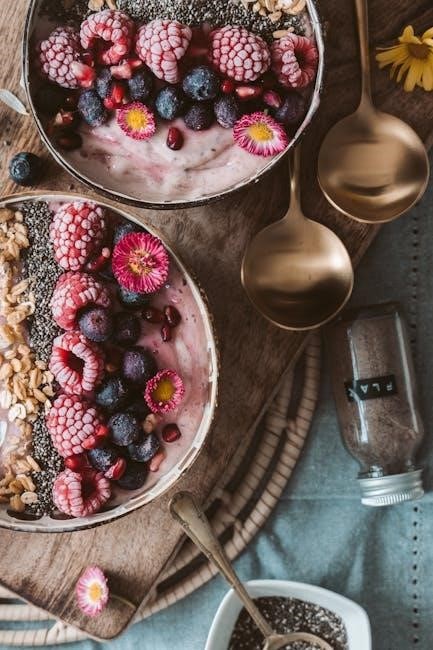
Breakfast options for a peptic ulcer diet should focus on bland, easily digestible foods. Consider whole grain cereals with low-fat milk, oatmeal, or scrambled eggs. Include non-acidic fruits like bananas or apples. Herbal teas or water are excellent beverage choices. Avoid citrus fruits and spicy additives to prevent irritation. These options help reduce stomach discomfort and promote healing.
10.2Lunch and Snack Ideas
For lunch, consider grilled chicken, fish, or steamed vegetables with whole grains like brown rice or quinoa. Snacks could include apples with peanut butter, whole grain crackers with cheese, or plain yogurt with honey. These options are gentle on the stomach, promoting healing without irritation. Avoid spicy or fatty foods, and opt for water or herbal teas to stay hydrated.
10.3Dinner Suggestions
Dinner options might include baked cod, steamed green beans, and mashed potatoes. Lean meats like turkey or chicken, paired with soft-cooked vegetables, are also ideal. Incorporate probiotic-rich foods like yogurt or kefir to aid digestion. Avoid heavy sauces or spices, and finish meals at least two hours before bedtime to prevent overnight acid reflux, promoting a restful recovery.
A balanced diet, avoiding irritants, and incorporating probiotics can effectively manage peptic ulcers. Consulting a healthcare provider ensures personalized care, promoting healing and preventing recurrence.
11.1Summary of Key Points
11.1 Summary of Key Points
A peptic ulcer diet focuses on avoiding irritants like spicy, acidic, and high-fat foods. Incorporating bland, easily digestible foods, high fiber, and probiotics supports healing. Small, frequent meals and avoiding late-night eating reduce symptoms. Lifestyle changes, such as quitting smoking and limiting alcohol, also aid recovery. A balanced diet tailored to individual needs is essential for managing symptoms and preventing recurrence.
11.2Final Tips for Managing Peptic Ulcers
11.2 Final Tips for Managing Peptic Ulcers
Adopt a balanced diet avoiding spicy, acidic, and high-fat foods. Incorporate probiotics and high-fiber foods to aid healing. Eat small, frequent meals and avoid late-night eating. Stay hydrated, quit smoking, and limit alcohol. Manage stress through relaxation techniques. Regularly monitor symptoms and consult a healthcare provider for adjustments. Consistency in dietary and lifestyle changes is key to managing peptic ulcers effectively.
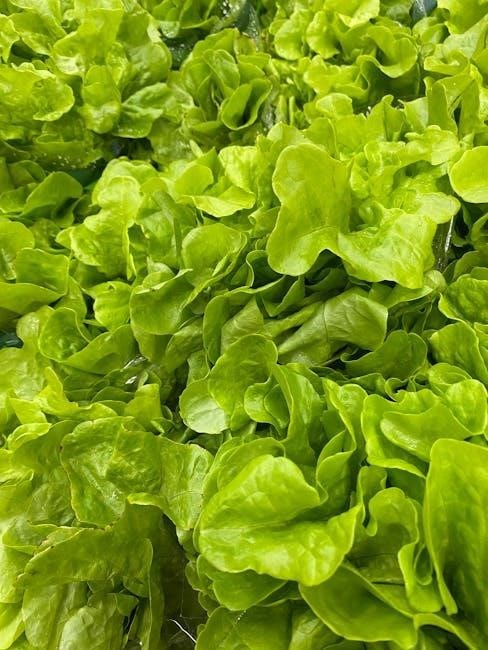
No Responses